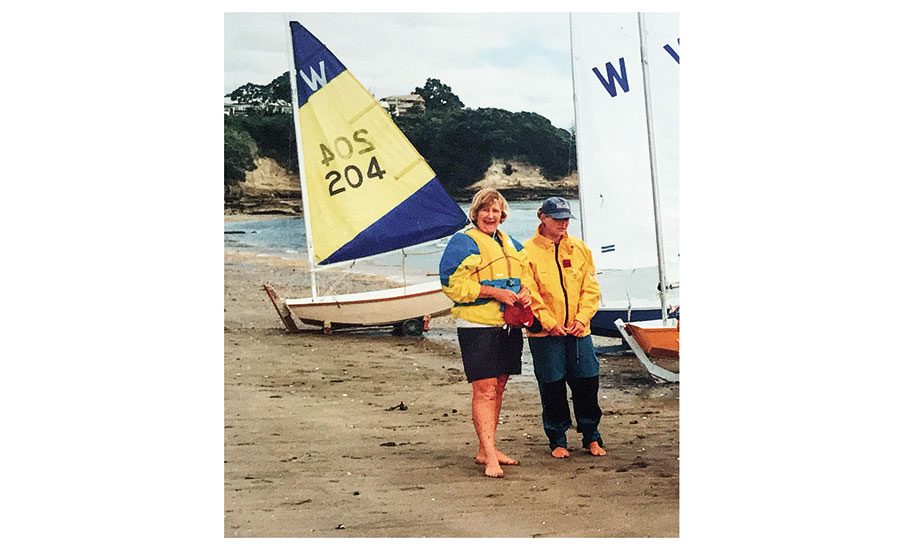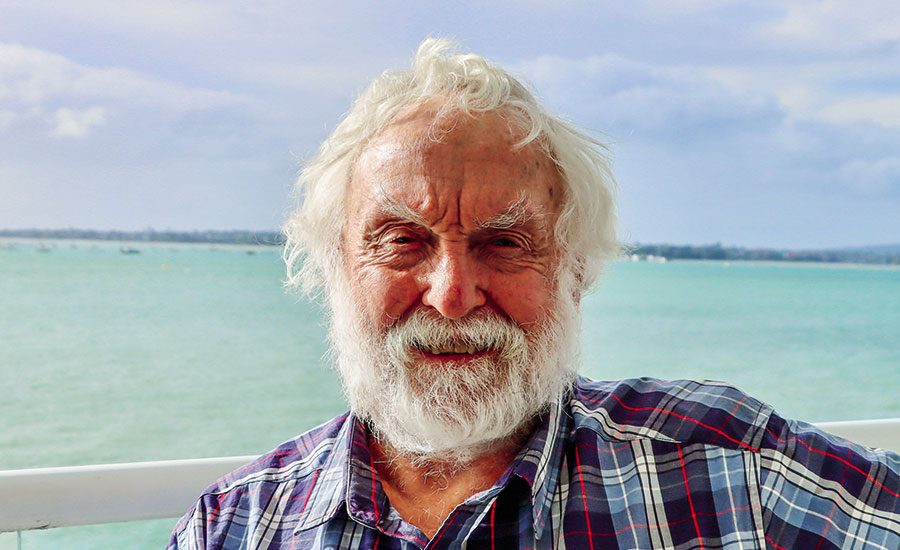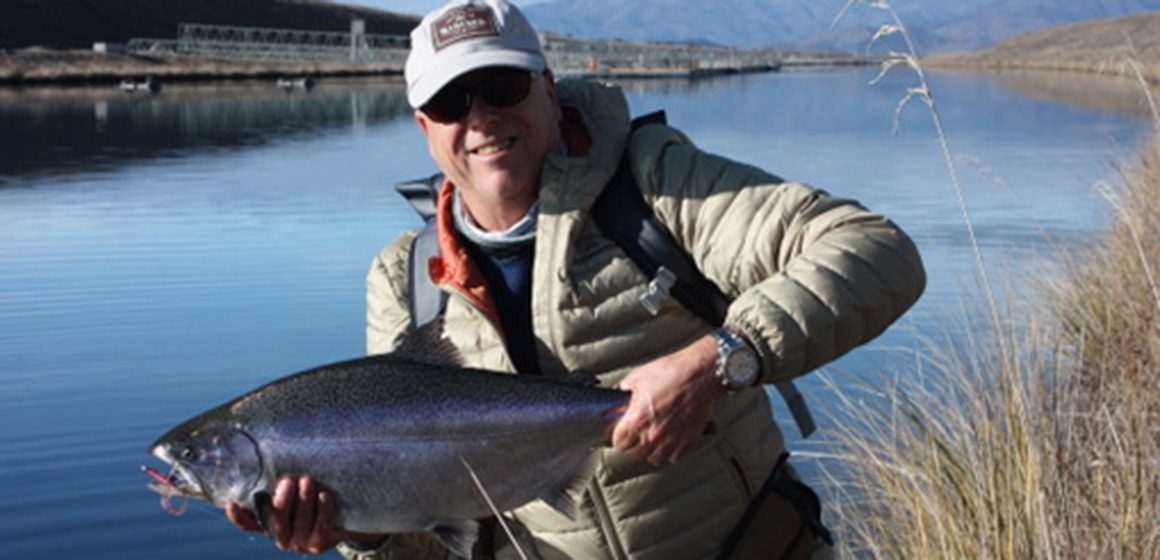

For more than 60 years Janet Watkins has worked tirelessly as a yachting volunteer. She’s done it all – sailing, racing, race management, learn-to-sail programmes, fundraising, driving patrol boats and tractors, a yacht club Commodore and countless stints on the Spirit of New Zealand. Here’s the story of a very special woman.
Janet’s story should begin with her father, Arthur Hereward (Pick) Pickmere, who grew up in Whangarei. There they got to know Harry Highet, who in 1920 designed and built a seven-foot dinghy he could sail solo.
Highet first sailed his dinghy in the 1920 Onerahi New Year’s Day regatta, where AR Pickmere (Arthur’s father) was so impressed he asked Highet to build him one. The Pickmeres and their cousin Joe Crompton later built a third and all three regularly raced and cruised in Whangarei Harbour. When Highet moved to Tauranga in the late 1920s his dinghy became the P Class.
After leaving school Pick trained as a surveyor. In 1928 he spent two years surveying the outer Fijian islands to update the Admiralty Charts, some of which dated back to Captain William Bligh. Realising he needed a better boat, he bought the 10.4m gaff cutter Arethusa in 1931 and sailed her back to Fiji for his surveying work.
 A busy day at Wakatere Boating Club.
A busy day at Wakatere Boating Club.
In Fiji he met and married Theodora (Buster) (nee Mortimer-Griffen). The couple returned to New Zealand in 1936 and set up in Kerikeri where Janet was born, the second of their four children.
Pick spent the war surveying the Northland Coast for the New Zealand Government – the RNZN needed updated charts in the event of a Japanese invasion – in those days a distinct possibility.
AR died in 1943 and Pick inherited his 10.4m launch Winsome, built by Bailey & Lowe in 1918. Arethusa was sold. Interestingly, AR was a dentist and had used Winsome as his mobile surgery in Whangarei Harbour and the Bay of Islands. In 1947 the Pickmere family moved from Kerikeri into AR’s old house on the edge of Whangarei Harbour.
Pick taught Janet to sail by pushing her into a P Class and saying “don’t come back until you can sail.”
 The view from the Pickmere family home.
The view from the Pickmere family home.
Despite a couple of capsizes, Janet quickly proved to be a natural sailor and, aged 14, Pick bought her the Silver Fern #22 Pierre. “At the time I was the only woman sailing dinghies and it was difficult to get other girls to crew.”
But with various boys and the occasional girl, Janet raced Pierre in the mixture of dinghies in Whangarei Harbour, with some success. “If it was blowing a gale we’d win because the Silver Fern was such a good seaboat.”
In 1956 (aged 19) Janet accompanied her father aboard Jim Lawler’s Fairmile Ngaroma, the mother ship for the first Auckland-to-Suva race. Not long afterwards she started a Survey Cadetship (a professional apprenticeship) with Pick, the first woman to do this in New Zealand.
She encountered some resistance: “You can’t do that. Girls can’t be surveyors”. But her response – “Why not?” – silenced that. Unquestionably, Janet would also have become the first woman surveyor in New Zealand, but when Buster died in 1957 she ceased work to look after her younger siblings.
In 1959 she moved to Auckland to take a job with the Lands and Survey Department. Two years later she married Max Watkins, a surveyor. The couple would eventually have three children – Greg, Doug and Toni.
 The first three prototypes of what would become the P Class.
The first three prototypes of what would become the P Class.
For a few years Janet was too busy with children and school volunteering to do much sailing. But she did find time to follow up her passion for native plants by helping the late Muriel Fisher write her first book – Gardening with Native Plants – in 1972.
Pick died in 1973 but with the writing experience under her belt, Janet produced the Pickmere Atlas of the Northland East Coast. This 30-page book contains all of Pick’s surveying work during the war years and is an invaluable aid to the standard charts. Self-published and reprinted nine times since then, Janet’s sold over 25,000 copies. Now out of print, the Atlas can still be found second-hand.
By this stage eldest son Greg had decided he wanted to sail and after a stint in a P Class – “it had to be a P” – graduated to a Starling which he raced at the Wakatere Boating Club (WBC). “So, I was back into sailing,” says Janet.
Typically, she was soon volunteering for the WBC, something she’s continued to this day. For over 40 years she’s helped the WBC with race management, the Secondary School Regattas, Teams Racing, Sunburst Class administration and a year as Commodore. “I’m just part of the furniture now.”
 Janet delivering another lesson
Janet delivering another lesson
Through WBC and the Takapuna Boating Club (TBC) she also ran a Learn-to-Sail programme for over 25 years, teaching countless children how to have fun, safely, in boats. “I used a fleet of Sabots for this programme. I like the Sabot because you have to sail them properly or they go nowhere.” One of her students was Elise Beavis, now a design engineer with Team New Zealand.
Janet passed on her hard-won experience by spending a decade as a Course Facilitator for Yachting New Zealand, teaching Level 1 and 2 Club Instructors. “I think it’s important to pass on knowledge.”
Having helped her father with race management in the late 1950s, she went on to become New Zealand’s first female National Race Officer. That made her a target. “The guys could make mistakes, but I wasn’t allowed any. I just made sure I knew the rules, procedures and systems backwards.”
In those days, while the sailing rules were simpler, the scoring system wasn’t, and a good knowledge of maths was essential. No problem for Janet: “I’ve always had a natural affinity for it.” Of course, Janet’s had her share of doubters. In 1960, while scoring a Cherub race a group of boys asked: “What do you know about sailing?” As always, she ignored them.
 The Bailey & Lowe launch Winsome.
The Bailey & Lowe launch Winsome.
But then a friend offered her his new Finn to try out. It was blowing 20 knots and Janet, being only 65kg, was well under the ideal weight. But she jumped in and took off, planing down the harbour, gybing and beating back. The boys were speechless as Janet casually sailed the Finn back on to the beach and stepped ashore.
Besides numerous club and school racing events, she’s done race management for countless National and International events – including for the Ponsonby Cruising Club (PCC), the Royal Akarana Yacht Club (RAYC), TBC and the Sail Auckland Regattas.
Janet became involved at PCC when her son Greg started crewing on mullet boats. She started crewing for Barry Simmonds in Taotane in the early 1980s and has remained involved ever since. “One Lipton Cup, we had four of us [Janet and her three children] in different boats swearing at each other.”
Over the years she’s held every position on mullet boats including helming. “What I like about them is that there’s six crew and no room for passengers. There’s a lot of strings and everyone has to know them all. Thankfully, I haven’t been for a swim in a mullet boat yet.”
The annual mullet championship is the Lipton Cup – run for the 100th time earlier this year. Janet believes it is the only Yacht Race with the same class of boat, under the same rules that’s run for 100 years without a break. It was even sailed during the 1948 polio epidemic, though without a prize-giving.
 Who needs a blackboard when you have a sandy beach at hand?
Who needs a blackboard when you have a sandy beach at hand?
She’s been helping out with the Lipton Cup race management for over 20 years now. “It’s always a date in my calendar.” She’s also in the closing stages of writing a book about the Lipton Cup – and it’s involved an inordinate amount of work. “I’ve been in the PCC basement for two years now, digging out all the old records.”
Besides dinghies and mullet boats, Janet’s also sailed in Stewart 34 and Young 88 woman’s series. But she’s not a fan of separate events for men and woman. “I’ve always raced in mixed events. The odd women’s event is good for beginners, but the higher they get up in their sailing the more they [women] want to compete on an equal basis.”
Around 2000 Janet became involved with the TBC when the clubhouse required restoration. She headed up the fundraising committee, which eventually raised over $650,000 to replace the roof and foundations of the listed Heritage building.
Unfortunately, it seems the current TBC committee has lost interest in retaining the building and there’s talk of selling it to developers. This is against the terms under which its title was originally granted through an Order in Council by an Act of Parliament. Janet believes selling the heritage building would be massive mistake – “once these buildings are sold, they’re gone forever.”
Her other involvement at the TBC was helping with race management for a number of world Championships held off Takapuna Beach – Tornado, Splash, 420, Laser Radial (Men and Women’s), RSX and Windsurfing.
Overseas sailors loved the TBC venue because the rigging area being grass allows them to tune their boats on their side without damage. The sailing conditions off the TBC are equally excellent. “There’s usually an excellent sea breeze without much tide and the cable zone prevents spectator boats anchoring there. It’s a world-class place for world-class events.”
Janet’s also been involved with the Spirit of Adventure and Spirit of New Zealand. She did her first 10-day sailing voyage in the former in 1980 and, over the next 20 years, carried out two or three 10-day voyages per year, mostly as a watch leader looking after 10 students.
She volunteered ashore too. In 1986 she did considerable work painting and splicing on the then-new Spirit of New Zealand. One of her jobs was making up the twin bow nets for the ship and, as they only last five years, she’s made the replacement nets ever since. That’s seven pairs of nets, each one taking more than 150m of twine. “A lot of knots in each one.”
Janet was born in an age when woman had little involvement in yachting – it was a male-dominated sport. For more than 60 years she’s ignored the status quo and broken the glass ceiling countless times. “When I’m told I can’t do something I always ask ‘Why not?’ And if there isn’t a valid reason I just go ahead and do it.”
Besides the countless children she’s helped become better sailors and leaders, Janet’s a living inspiration to young women everywhere: if they can dream a goal, they can certainly achieve it.
Janet Watkins – une femme formidable! BNZ




